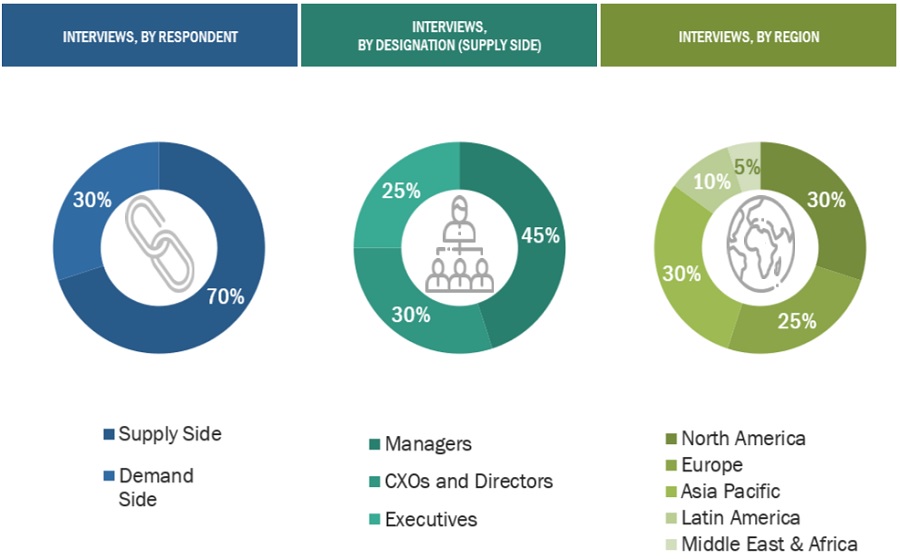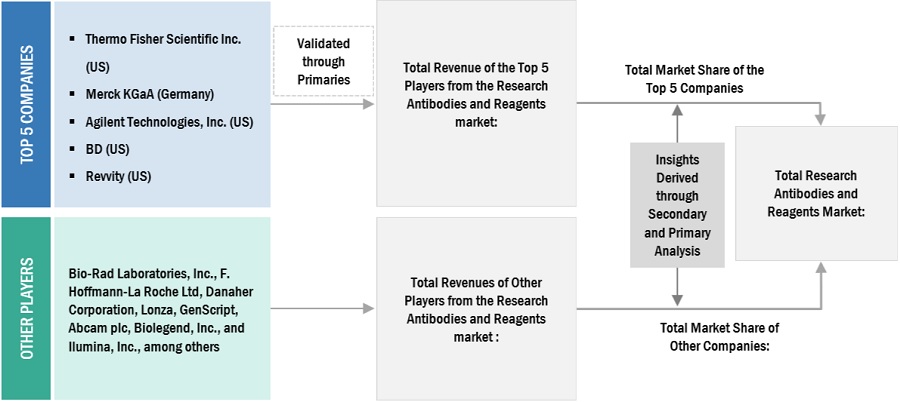This study involved the extensive use of both primary and secondary sources. The research process involved the study of various factors affecting the industry to identify the segmentation types, industry trends, key players, competitive landscape, key market dynamics, and key player strategies.
Secondary Research
This research study involved the use of widespread secondary sources; directories; databases such as Dun & Bradstreet, Bloomberg Businessweek, and Factiva; white papers; annual reports; and companies’ house documents. Secondary research was used to identify and collect information for this extensive, technical, market-oriented, and commercial study of the global research antibodies and reagents market. It was also used to obtain important information about the top players, market classification, and segmentation according to industry trends to the bottom-most level, geographic markets, key developments related to market, and technology perspectives. A database of the key industry leaders was also prepared using secondary research.
Primary Research
In the primary research process, various sources from both the supply and demand sides were interviewed to obtain qualitative and quantitative information for this report. The primary sources from the supply side included industry experts, such as CEOs, vice presidents, marketing and sales directors, technology & innovation directors, and related key executives from various key companies and organizations operating in the global research antibodies and reagents market. The primary sources from the demand side included industry experts, such as life science researchers.
A breakdown of the primary respondents is provided below:

To know about the assumptions considered for the study, download the pdf brochure
Market Size Estimation
The market size estimates and forecasts provided in this study are derived through a mix of the bottom-up approach (segmental analysis of major segments) and top-down approach (assessment of utilization/adoption/penetration trends, by product, technology, application, end user, and region).
Bottom-up Approach
-
The key players in the industry and market have been identified through extensive secondary research.
-
The revenues generated from the research antibodies and reagents business of leading players have been determined through primary and secondary research.
-
All percentage shares, splits, and breakdowns have been determined using secondary sources and verified through primary sources

To know about the assumptions considered for the study, Request for Free Sample Report
Top-down Approach
After arriving at the overall market size from the market size estimation process, the total market was split into several segments and subsegments.

Data Triangulation
To complete the overall market engineering process and arrive at the exact statistics for all segments and subsegments, data triangulation and market breakdown procedures were employed, wherever applicable. The data was triangulated by studying various factors and trends from both the demand and supply sides.
Market Definition
Antibodies are proteins that bind to specific antigens, and reagents are chemicals or other substances used in chemical reactions. Antibodies and reagents are important components in life science research for the investigation of biological processes or causes of diseases through careful experimentation, observation, laboratory work, analysis, and testing.
Stakeholders
-
Pharmaceutical and Biotechnology Companies
-
Research Laboratories
-
Life Sciences Companies
-
Academic Research Institutes
-
Government Institutes
-
Private Research Firms
-
Contract Research Organizations (CROs)
-
Venture Capitalists and Investors
Objectives of the Study
-
To define, describe, segment, and forecast the global research antibodies and reagents market based on the product, technology, application, end user, and region
-
To provide detailed information regarding the major factors influencing the market growth (drivers, restraints, opportunities, and industry-specific challenges)
-
To analyze micro markets with respect to individual growth trends, prospects, and contributions to the overall market
-
To analyze the market opportunities for stakeholders and provide details of the competitive landscape for market players
-
To forecast the size of the global research antibodies and reagents market in five main regions (along with countries)—North America, Europe, Asia Pacific (APAC), Latin America, and the Middle East and Africa (MEA)
-
To profile key players in the global research antibodies and reagents market and comprehensively analyze their core competencies2 and market shares
-
To track and analyze competitive developments, such as product/technology development, partnerships, mergers, acquisitions, and expansions, and the R&D activities of the leading players in the research antibodies and reagents market
-
To benchmark players within the research antibodies and reagents market using the "Competitive Leadership Mapping" framework, which analyzes market players on various parameters within the broad categories of business and product strategy
Available Customizations
With the given market data, MarketsandMarkets offers customizations as per the company’s specific needs. The following customization options are available for this report:
Portfolio Assessment
-
Product Matrix, which gives a detailed comparison of the product portfolios of the top three companies.
Company Information
-
Detailed analysis and profiling of additional market players (up to three).
Geographical Analysis
-
A further breakdown of the Rest of Asia Pacific research antibodies and reagents market into countries
-
A further breakdown of the Rest of European research antibodies and reagents market into countries
-
A further breakdown of the Rest of Latin American research antibodies and reagents market into countries



Growth opportunities and latent adjacency in Research Antibodies & Reagents Market